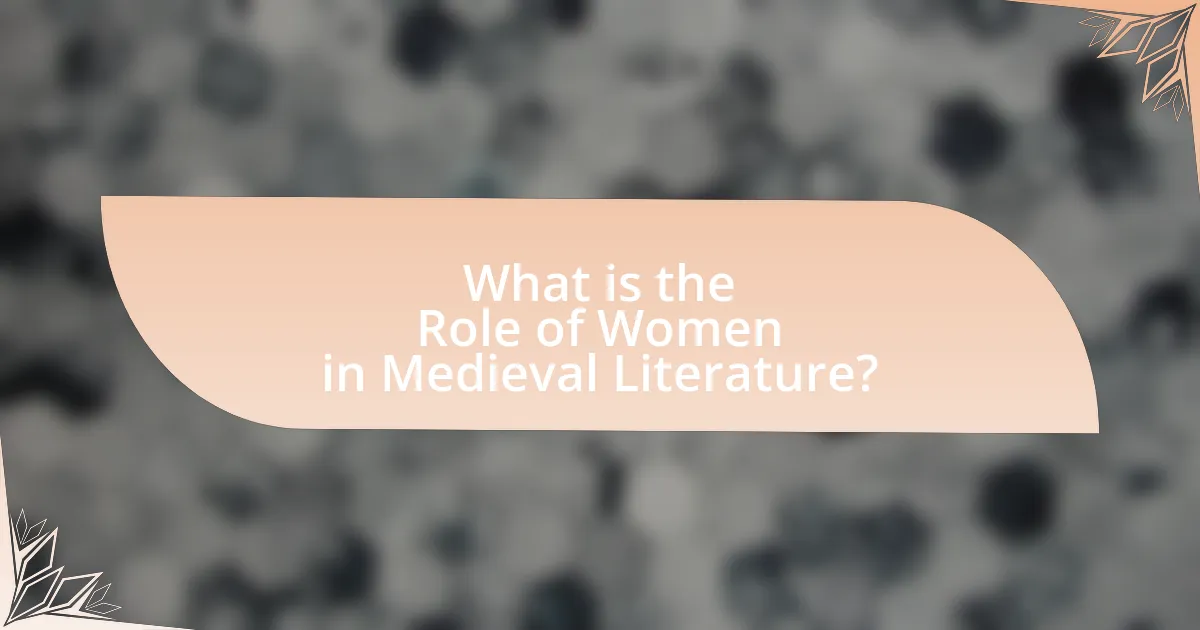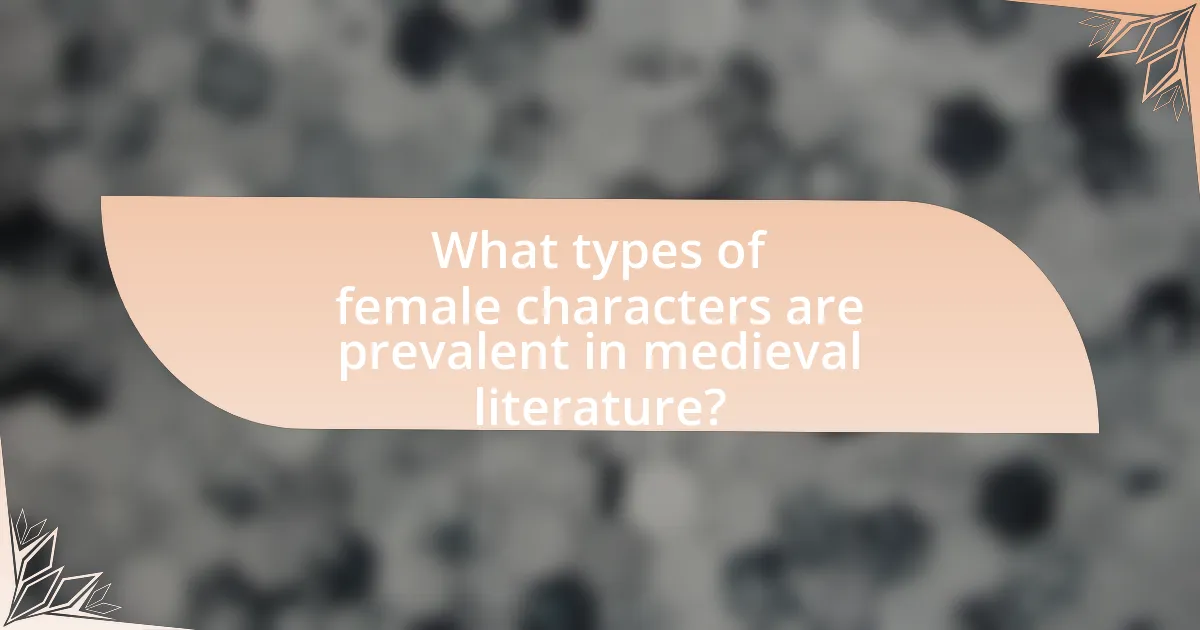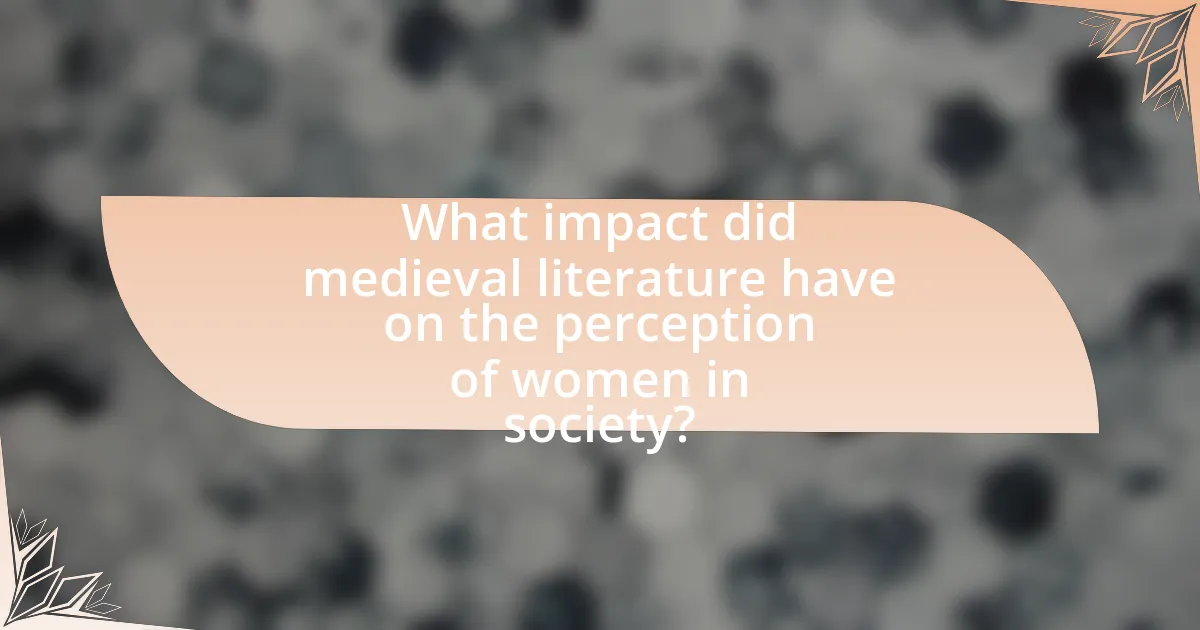The article examines the role of women in medieval literature, highlighting their multifaceted representations that reflect societal norms and expectations of the time. It discusses how women are often depicted as virtuous figures or temptresses, with notable examples from works like “The Canterbury Tales” and “The Book of the City of Ladies.” The article also explores common themes associated with female characters, the influence of societal and religious contexts, and the impact of female authors on literary representations. Additionally, it analyzes the distinctions between noblewomen and peasant women, the significance of archetypes such as the femme fatale, and the broader implications of these portrayals on contemporary discussions about gender roles and equality.

What is the Role of Women in Medieval Literature?
The role of women in medieval literature is multifaceted, often reflecting societal norms and expectations of the time. Women are frequently depicted as either virtuous figures, such as the idealized lady or the chaste wife, or as temptresses, embodying moral challenges for male characters. For example, in works like “The Canterbury Tales” by Geoffrey Chaucer, characters such as the Wife of Bath challenge traditional gender roles, presenting women as assertive and capable of independent thought. Additionally, female authors like Christine de Pizan, in “The Book of the City of Ladies,” advocate for women’s rights and intellectual capabilities, illustrating a shift in the perception of women during the medieval period. These representations reveal the complexities of women’s roles, showcasing both their limitations and their agency within the literary canon of the time.
How were women represented in medieval literary works?
Women in medieval literary works were often represented through a lens of idealization and moral virtue, frequently embodying roles such as the chaste maiden, the devoted wife, or the wise matriarch. For instance, in works like “The Canterbury Tales” by Geoffrey Chaucer, women are depicted with a range of characteristics, from the strong-willed Wife of Bath to the virtuous Griselda, illustrating both agency and subservience. Additionally, texts such as “Sir Gawain and the Green Knight” present women as pivotal figures influencing male protagonists, showcasing their importance in the narrative structure. This representation reflects the societal norms of the time, where women’s roles were largely defined by their relationships to men, yet also highlights moments of female strength and influence within the constraints of a patriarchal society.
What are the common themes associated with female characters in medieval literature?
Common themes associated with female characters in medieval literature include virtue, chivalry, and the tension between agency and societal constraints. Female characters often embody ideals of purity and moral integrity, as seen in figures like Beatrice from Dante’s “Divine Comedy,” who represents divine love and virtue. Additionally, themes of chivalry manifest through women being portrayed as objects of knights’ quests, exemplified by characters such as Guinevere in Arthurian legends, who inspires heroic deeds. Furthermore, many female characters navigate the limitations imposed by patriarchal societies, reflecting the struggle for autonomy, as illustrated by the character of Lady Macbeth in Shakespeare’s works, who challenges gender norms yet ultimately faces dire consequences. These themes highlight the complexity of women’s roles and the societal expectations of the medieval period.
How do the portrayals of women differ across various genres of medieval literature?
The portrayals of women in medieval literature vary significantly across genres, reflecting differing societal norms and values. In chivalric romances, women are often idealized as noble figures, embodying virtues such as purity and grace, exemplified by characters like Guinevere in Arthurian legends. Conversely, in religious texts, women may be depicted as pious and submissive, serving primarily as moral exemplars or cautionary figures, as seen in the lives of saints. In contrast, fabliaux often portray women in a more comedic or subversive light, highlighting their sexuality and cunning, as demonstrated in tales where female characters outsmart male counterparts. These genre-specific portrayals reveal the complex and multifaceted roles women occupied in medieval society, influenced by the cultural and literary contexts of their respective genres.
What societal influences shaped the depiction of women in medieval literature?
Societal influences that shaped the depiction of women in medieval literature include the prevailing patriarchal norms, religious doctrines, and social hierarchies of the time. Patriarchal norms dictated that women were often portrayed as subservient to men, reflecting their limited roles in society, which is evident in works like “The Canterbury Tales” by Geoffrey Chaucer, where female characters often embody traditional roles. Religious doctrines, particularly those of the Catholic Church, emphasized women’s purity and virtue, leading to idealized representations such as the Virgin Mary, which influenced literary portrayals of women as paragons of chastity and morality. Additionally, social hierarchies based on class and status further defined women’s roles, as seen in the contrast between noblewomen and peasant women in literature, highlighting their varying degrees of agency and influence. These societal factors collectively shaped the literary landscape, reinforcing and reflecting the cultural attitudes towards women during the medieval period.
How did the historical context impact women’s roles in literature during the medieval period?
The historical context significantly impacted women’s roles in literature during the medieval period by restricting their participation and shaping their representation. During this time, societal norms dictated that women were primarily confined to domestic roles, limiting their access to education and literary expression. Consequently, most literary works were authored by men, and women were often depicted in stereotypical roles, such as the idealized lady or the temptress, reflecting the patriarchal values of the era. For instance, texts like “The Canterbury Tales” by Geoffrey Chaucer illustrate women’s roles through characters like the Wife of Bath, who challenges traditional views, yet remains a product of her time. This duality highlights how historical constraints influenced both the creation and portrayal of female characters in medieval literature.
What role did religion play in shaping the literary representation of women?
Religion significantly influenced the literary representation of women by establishing moral frameworks and societal expectations that authors reflected in their works. In medieval literature, women were often depicted through the lens of religious ideals, such as purity, piety, and obedience, which were central to Christian doctrine. For instance, characters like the Virgin Mary served as archetypes of virtue, shaping the portrayal of female figures in texts like “The Pearl” and “The Divine Comedy.” These representations reinforced the notion that women’s value was tied to their adherence to religious principles, thus limiting their roles to those of saints or sinners. Additionally, the Church’s teachings often dictated the narrative arcs of female characters, emphasizing their subservience and moral dilemmas, as seen in works like “The Canterbury Tales.” This intertwining of religion and literature not only reflected societal norms but also perpetuated them, illustrating the profound impact of religious beliefs on the literary depiction of women during the medieval period.

What types of female characters are prevalent in medieval literature?
Medieval literature features several prevalent types of female characters, including the virtuous lady, the femme fatale, the wise woman, and the chaste maiden. The virtuous lady often embodies ideals of purity and loyalty, as seen in works like “Sir Gawain and the Green Knight,” where women represent moral guidance. The femme fatale, exemplified by characters such as Morgan le Fay in Arthurian legends, often uses her beauty and cunning to manipulate men. The wise woman, often a healer or advisor, appears in texts like “The Canterbury Tales,” where characters like the Wife of Bath challenge societal norms. Lastly, the chaste maiden, often depicted as a damsel in distress, is a common trope in romances, emphasizing themes of honor and virtue. These character types reflect the complex roles women played in medieval society and literature, illustrating both societal ideals and challenges.
What archetypes of women can be identified in medieval texts?
In medieval texts, several archetypes of women can be identified, including the Virgin, the Mother, the Temptress, and the Wise Woman. The Virgin archetype represents purity and chastity, often embodied by figures like the Virgin Mary, who symbolizes ideal femininity and moral virtue. The Mother archetype reflects nurturing and fertility, as seen in characters like Beatrice in Dante’s “Divine Comedy,” who represents guidance and maternal love. The Temptress, or femme fatale, is characterized by seduction and manipulation, exemplified by figures such as Guinevere in Arthurian legends, who leads men to their downfall. Lastly, the Wise Woman archetype embodies knowledge and authority, often depicted in roles such as the healer or advisor, as seen in characters like Morgan le Fay. These archetypes illustrate the complex roles women played in medieval society and literature, reflecting societal values and expectations of the time.
How do the roles of noblewomen differ from those of peasant women in literature?
Noblewomen in literature often occupy roles that emphasize power, influence, and social status, while peasant women are depicted in roles focused on labor, family, and survival. For instance, noblewomen frequently engage in political alliances, manage estates, and wield social influence, as seen in works like “The Canterbury Tales” by Geoffrey Chaucer, where characters like the Wife of Bath assert their authority and independence. In contrast, peasant women are typically portrayed as caretakers and laborers, reflecting their daily struggles and responsibilities, as illustrated in texts such as “The Pearl” where the focus is on domestic life and hardship. This distinction highlights the varying societal expectations and experiences of women based on their social class during the medieval period.
What is the significance of the femme fatale archetype in medieval narratives?
The femme fatale archetype in medieval narratives signifies the complex interplay of female power and danger, often embodying themes of seduction and betrayal. This archetype serves to challenge traditional gender roles by portraying women as both alluring and threatening, which reflects societal anxieties about female sexuality and autonomy. For instance, characters like Morgan le Fay in Arthurian legends exemplify this duality, as they wield significant influence while also being depicted as morally ambiguous figures. Such representations highlight the tension between admiration and fear of female agency in a patriarchal context, ultimately shaping the narrative dynamics and moral lessons within medieval literature.
How do female authors contribute to the representation of women in medieval literature?
Female authors contribute to the representation of women in medieval literature by providing diverse perspectives and voices that challenge traditional gender roles. Notable examples include Christine de Pizan, who, in her work “The Book of the City of Ladies,” constructs a narrative that celebrates women’s achievements and critiques the misogyny prevalent in her time. This text serves as a foundational piece in feminist literature, illustrating how female authors can reshape narratives to empower women. Additionally, female authors often depict complex female characters, allowing for a richer understanding of women’s experiences in a patriarchal society. Their contributions not only enhance the literary landscape but also influence contemporary discussions on gender and representation.
What works by female authors are significant in the context of medieval literature?
Significant works by female authors in medieval literature include “The Book of the City of Ladies” by Christine de Pizan and “The Divine Comedy” by Dante Alighieri, which features the character Beatrice, representing female influence. Christine de Pizan’s work, written in the early 15th century, is notable for its defense of women’s roles and contributions to society, marking a pivotal moment in feminist literature. Additionally, “The Canterbury Tales” by Geoffrey Chaucer includes the “Wife of Bath’s Tale,” which presents a strong female voice and challenges contemporary gender norms. These texts illustrate the impact of female perspectives in a predominantly male literary landscape during the medieval period.
How do female authors challenge or reinforce contemporary views of women through their writing?
Female authors challenge contemporary views of women through their writing by subverting traditional gender roles and presenting complex female characters. For instance, authors like Christine de Pizan in “The Book of the City of Ladies” advocate for women’s intellectual capabilities and moral strength, directly opposing the prevailing notion of female inferiority in medieval society. Additionally, female authors reinforce contemporary views by adhering to societal norms in their narratives, often portraying women in roles that emphasize domesticity and obedience, as seen in works like “The Canterbury Tales” by Geoffrey Chaucer, where female characters often reflect the expectations of their time. This duality in their writing illustrates how female authors navigate and influence the perceptions of women in their historical context.

What impact did medieval literature have on the perception of women in society?
Medieval literature significantly shaped the perception of women in society by often portraying them in roles that reinforced traditional gender norms. Texts such as “The Canterbury Tales” by Geoffrey Chaucer and “The Pearl” reflect a dichotomy in female representation, showcasing women as either virtuous and submissive or as manipulative and dangerous. For instance, the character of the Wife of Bath challenges societal expectations by asserting her sexual autonomy and experience, which prompted discussions about women’s roles and rights. Conversely, works like “Sir Gawain and the Green Knight” depict women as temptresses, reinforcing the idea of women as sources of moral danger. This duality in representation influenced societal views, often limiting women’s roles to either idealized figures or cautionary tales, thus impacting their status and agency in medieval society.
How did literary portrayals of women influence societal norms and expectations?
Literary portrayals of women significantly influenced societal norms and expectations by shaping perceptions of gender roles and behaviors. In medieval literature, characters such as Guinevere in Arthurian legends and the women in Chaucer’s “The Canterbury Tales” often reflected and reinforced the ideals of femininity, virtue, and obedience, which were prevalent in society at the time. These portrayals established a framework for how women were expected to behave, often emphasizing their roles as passive, nurturing figures or as objects of desire, thereby limiting their agency. Historical texts, such as “The Book of the City of Ladies” by Christine de Pizan, challenged these norms by presenting women as capable and influential, suggesting that literature could also serve as a vehicle for social change. Thus, the literary representations of women not only mirrored existing societal expectations but also had the potential to reshape them by introducing alternative narratives.
What role did literature play in shaping gender roles during the medieval period?
Literature played a significant role in shaping gender roles during the medieval period by reinforcing societal norms and expectations regarding masculinity and femininity. Texts such as “The Canterbury Tales” by Geoffrey Chaucer and “The Romance of the Rose” illustrated the ideals of chivalry and courtly love, often portraying women as objects of desire or virtuous figures, which influenced contemporary views on women’s roles in society. Additionally, religious texts and didactic literature emphasized women’s subservience and moral purity, further entrenching traditional gender roles. The portrayal of women in these literary works not only reflected existing societal attitudes but also helped to perpetuate and solidify them, impacting the lived experiences of women during the medieval era.
How did the depiction of women in literature reflect or challenge the realities of women’s lives?
The depiction of women in literature during the medieval period both reflected and challenged the realities of women’s lives by illustrating their societal roles and, at times, subverting those roles. For instance, texts like “The Canterbury Tales” by Geoffrey Chaucer present women in various capacities, from the submissive Wife of Bath to the assertive and independent characters, showcasing the complexities of female existence. Additionally, the character of Lady Macbeth in Shakespeare’s “Macbeth” challenges traditional gender norms by exhibiting ambition and power, which were often denied to women in reality. Such portrayals not only mirrored the constraints placed on women but also provided a platform for questioning and redefining their roles within society.
What lessons can modern readers learn from the role of women in medieval literature?
Modern readers can learn about the complexities of women’s roles and societal expectations in medieval literature, which often reflect broader themes of power, agency, and identity. For instance, characters like Guinevere in Arthurian legends illustrate the tension between personal desire and societal duty, highlighting how women’s choices were often constrained by patriarchal structures. Additionally, works such as “The Canterbury Tales” by Geoffrey Chaucer present women with varying degrees of autonomy and influence, showcasing their ability to navigate and sometimes subvert societal norms. These portrayals encourage contemporary readers to critically examine the historical context of gender roles and recognize the ongoing relevance of these themes in today’s discussions about gender equality and women’s rights.
How can the analysis of women’s roles in medieval literature inform contemporary discussions on gender?
The analysis of women’s roles in medieval literature can inform contemporary discussions on gender by highlighting the historical context and evolution of gender norms. Medieval texts often depict women in various roles, from powerful figures like queens to marginalized characters, reflecting societal attitudes towards gender. For instance, works such as “The Canterbury Tales” by Geoffrey Chaucer showcase diverse female perspectives, illustrating both agency and subjugation. This complexity allows modern scholars to examine how these historical representations influence current gender dynamics and stereotypes. By understanding the multifaceted portrayals of women in medieval literature, contemporary discussions can better address ongoing issues of gender inequality and representation in society.
What are the best practices for studying the role of women in medieval literature today?
The best practices for studying the role of women in medieval literature today include employing a multidisciplinary approach, utilizing feminist literary theory, and analyzing historical context. A multidisciplinary approach allows scholars to incorporate insights from history, sociology, and gender studies, enhancing the understanding of women’s roles. Utilizing feminist literary theory enables a critical examination of texts, revealing how gender dynamics shape narratives and characterizations. Analyzing historical context is crucial, as it provides insight into the societal norms and expectations of women during the medieval period, which can be seen in works like “The Canterbury Tales” by Geoffrey Chaucer and “The Book of the City of Ladies” by Christine de Pizan, where women’s experiences and representations are central themes. These practices collectively contribute to a more nuanced understanding of women’s roles in medieval literature.